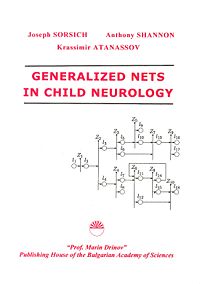Please check our Instructions to Authors and send your manuscripts to nifs.journal@gmail.com.
Generalized Nets in Child Neurology
(Redirected from Generalized nets in child neurology)

Generalized Nets in Child Neurology is a book by Joseph Sorsich, Anthony Shannon and Krassimir Atanassov, published in 2002 by the "Prof. Marin Drinov" Publishing House of the Bulgarian Academy of Sciences under ISBN 954-430-906-3.
The book contains a series of generalized net models in child neurology and can be considered a continuation of the books Generalized Nets in Neurology (1997), Generalized Nets in General and Internal Medicine (volume 1: 1998, volume 2: 1999, volume 3: 2000). The models were prepared on the basis of the book "Decision Making in Child Neurology" by David W. Dunn and Leon G. Epstein, Toronto 1987.
Table of contents
- Preface
- CN01: Mental retardation
- CN02: Progressive retardation
- CN03: Episodic loss of function
- CN04: Hallucinations and illusions
- CN05: Coma
- CN06: Episodic sleep disturbances
- CN07: Insomnia
- CN08: Hypersomnia
- CN09: Enuresis
- CN10: Macrocephaly
- CN11: Microcephaly
- CN12: Visual loss
- CN13: Nystagmus
- CN14: Diplopia, ocular misalignment
- CN15: Pupillary disorders
- CN16: Facial weakness
- CN17: Vertigo
- CN18: Speech disorders
- CN19: Apnea
- CN20: Acute weakness
- CN21: Chronic weakness
- CN22: Hypertonia
- CN23: Hypotonia
- CN24: Paraparesis and quadriparesis
- CN25: Muscle cramps
- CN26: Ataxia
- CN27: Chorea
- CN28: Tics
- CN29: Myoclonus
- CN30: Tremor
- CN31: Dystonia
- CN32: Torticollis
- CN33: Acute headache
- CN34: Chronic headache
- CN35: Migraine
- CN36: Back pain
- CN37: Limb pain
- CN38: Numbness and paresthesia
- CN39: Asphyxia
- CN40: Periventricular-intraventricular hemorrhage
- CN41: Perinatal trauma
- CN42: Brachial plexus injury
- CN43: Neonatal seizure
- CN44: The floppy infant
- CN45: Phenylketonuria
- CN46: Chromosomal anomalies
- CN47: Myelodysplasia
- CN48: Hydrocephalus
- CN49: Shunt malfunction
- CN50: Congenital joint contractures (arthrogryposis multiplex congenita)
- CN51: Cerebral palsy
- CN52: The first afebrile seizure
- CN53: Febrile seizures
- CN54: Infantile spasms
- CN55: Minor motor seizures
- CN56: Absence seizures
- CN57: Generalized tonic clonic seizures
- CN58: Partial seizures
- CN59: Intractable seizures
- CN60: Status epilepticus
- CN61: Discontinuation of medication in children with epilepsy
- CN62: The use of anticonvulsant drugs
- CN63: Nonepileptiform paroxysmal disorders
- CN64: Increased intracranial pressure
- CN65: Posterior fossa (infratentorial) tumor
- CN66: Midline cerebral tumor
- CN67: Suprasellar and chiasmatic tumor
- CN68: Hemispheric cerebral tumor
- CN69: Optic pathway tumor
- CN70: Neurofibromatosis
- CN71: Tuberous sclerosis
- CN72: Spinal cord tumor
- CN73: Head trauma
- CN74: Spinal cord trauma
- CN75: Brain abscess
- CN76: Possible meningitis
- CN77: Neurological complications of bacterial meningitis
- CN78: Encephalitis
- CN79: Reye's syndrome
- CN80: Acquired immunodeficiency syndrome
- CN81: Intrauterine torch infections
- CN82: Language delay
- CN83: Learning disability
- CN84: Hyperactivity
- CN85: Autism and childhood psychosis
- CN86: Myopathy
- CN87: Polymyositis (dermatomyositis)
- CN88: Myasthenia gravis and myasthenia syndromes
- CN89: Motor neuron disorders
- CN90: Peripheral neuropathy
- CN91: Failure to thrive
- CN92: Scoliosis
- CN93: Occlusive cerebrovascular disease
- CN94: Heart disease
- CN95: Near drowning and respiratory arrest
- CN96: Renal disease
- CN97: Leukemia: encephalopathy
- CN98: Spinal cord lesions and cranial neuropathies in leukemia
- CN99: Diabetes mellitus
- CN100: Brain death
- Bibliography